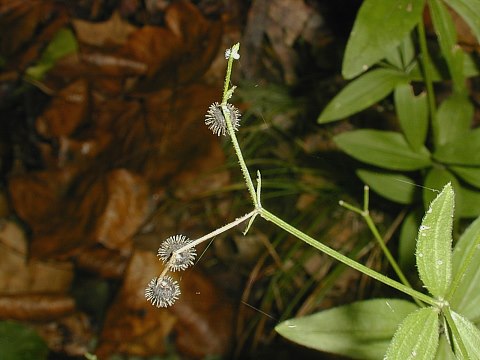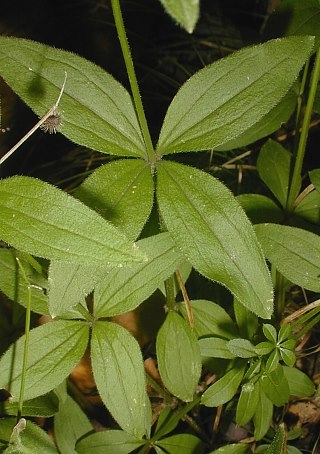Description: This perennial wildflower is ¾–2' tall with erect to ascending stems. These stems are sometimes branched at the base, otherwise they are unbranched (except when axillary inflorescences are present). The stems are light green, 4-angled, and glabrous to sparsely hairy. At intervals along these stems, there are whorls of 4 leaves. The leaves are up to 2½" long and 1" across, lanceolate-ovate to ovate, medium green, sessile, and sparsely pubescent on both the lower and upper sides. Their margins are smooth and ciliate. Each leaf has 3 prominent parallel veins. Usually, the leaves toward the middle of each stem are largest. Each major stem terminates in a dichotomously forked inflorescence that produces only a few flowers; sometimes smaller inflorescences develop from the axils of the upper leaves. Like the stems, the branches of each inflorescence are 4-angled, light green, and glabrous to sparsely hairy. At each fork of the inflorescence, there are 0-4 small bracts that are linear or linear-lanceolate in shape.

The flowers occur
individually along these branches and they are usually sessile (or
nearly so). Each flower is about 1/8" (3 mm.) across, consisting of a
corolla
with 4 lobes, a double-ovoid ovary, 4 stamens, and a pair of styles.
The corolla is usually greenish white or greenish yellow; less often,
it is purple. The immature ovary is green, bristly, and 2-celled. The
blooming period usually occurs during the early summer and lasts about
a month. At maturity, each ovary becomes a dry fruit that is black or
dark brown, globoid in shape, and covered with hooked bristles. One
cell of this fruit produces a single nutlet, while the other cell
becomes a small fleshy elaiosome (food appendage). The root system is
fibrous and rhizomatous. This wildflower spreads by reseeding itself or
vegetatively through its rhizomes.
Cultivation:
The preference is dappled sunlight to medium shade, mesic to dry
conditions, and a loamy or rocky soil with some decaying organic matter
(e.g., fallen leaves). The foliage usually remains in good condition
throughout the summer.
Range & Habitat:
The native Wild Licorice is occasional to locally common throughout
Illinois (see Distribution
Map). Habitats include mesic to dry deciduous woodlands,
bluffs, woodland borders, areas along woodland paths, thickets, and
limestone glades.

Faunal
Associations:
The flowers are visited sparingly by small bees and miscellaneous
flies; these insects usually seek nectar. The caterpillars of several
moths feed on Galium spp. (Bedstraws), including Lobocleta
ossularia (Drab Brown Wave), Pleuroprucha insulsaria
(Common Tan Wave), Scopula limboundata (Large Lace
Border), Epirrhoe alternata (White-banded Toothed
Carpet), and Hyles gallii (Galium Sphinx).
Bedstraws are summer hosts of Myzus cerasi (Black
Cherry Aphid); another aphid, Aphis gossypii
(Cotton Aphid), has been found on the leaves of Wild Licorice. Among
vertebrate animals, the Eastern Box Turtle occasionally eats the
foliage of bedstraws in woodlands; White-tailed Deer also eat the
foliage of these plants to a limited extent. The hooked bristles of the
fruits can cling to the fur of mammals and the clothing of humans; this
distributes the seeds into new areas. Because each fruit contains an
elaiosome that is attractive to ants, these insects also help to
distribute the seeds.
Photographic Location:
A deciduous woodland at Pine Hills Nature Preserve in west-central
Indiana.
Comments:
While the flowers are not very showy, the foliage is reasonably
attractive. Wild Licorice has larger leaves than most Galium
spp. (Bedstraws). In addition to this characteristic, it can
be distinguished from other bedstraws by its whorls of 4 leaves,
pubescent leaves, bristly fruit, and/or flowers that are sessile along
the branches of each inflorescence. A very similar species, Galium
lanceolatum (Lance-Leaved Wild Licorice), has hairless leaves
that are more narrow toward their tips, and its flowers are usually
purple. Both of these species prefer shaded habitats that are rather
dry.